Abstract
This article examines the long tradition of Spanish-language learning for scientific and technological purposes in the United States. It provides a review of some of the historical approaches for designing course offerings and programs of Spanish for STEM (science, technology, engineering, and mathematics) at the college level. These historical approaches help us better understand the unique challenges Spanish for STEM educators and scholars have faced at different times and the perspectives that have shaped the current state of the field. The author also describes current pedagogical models within the field of Languages for Specific Purposes (LSP) but also International Engineering Education (IEE) and Cultures and Languages Across the Curriculum (CLAC). Finally, the author articulates future perspectives and possible directions of the field, including more emphasis on needs-analysis curriculum design and more active engagement with developments in other geographies, language traditions, and areas of LSP. This article seeks to encourage the growth of Spanish for STEM at institutions of higher education, whether in language departments or science and engineering programs.
DOI
https://doi.org/10.4079/gbl.v21.1
This work is licensed under a Creative Commons Attribution-NonCommercial-NoDerivatives 4.0 International License.

